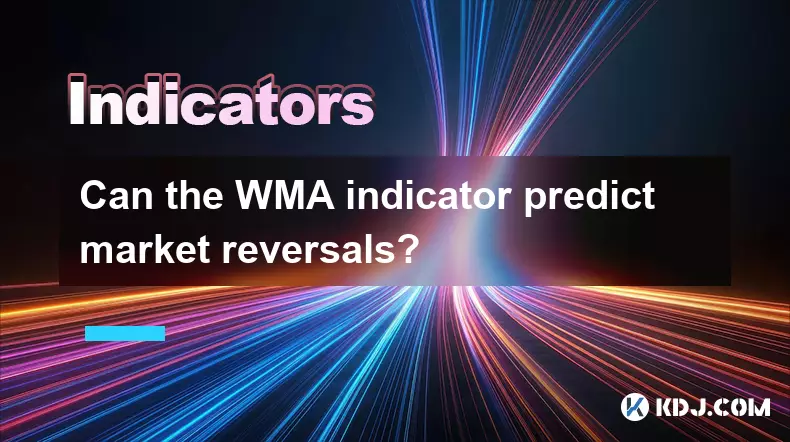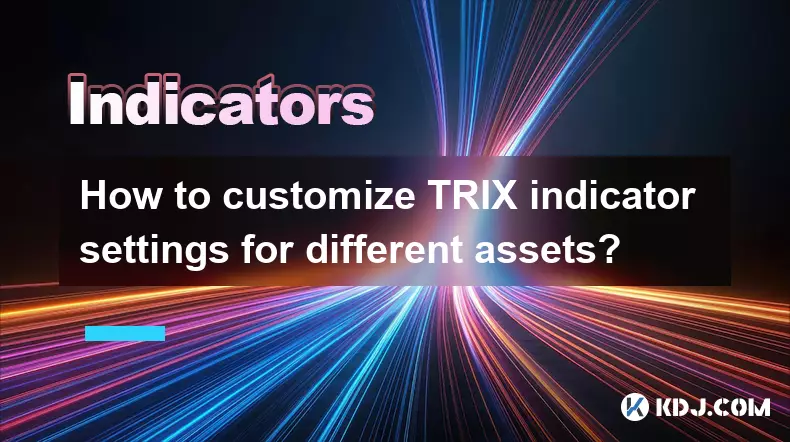-
 bitcoin
bitcoin $102877.190955 USD
1.88% -
 ethereum
ethereum $3430.435064 USD
4.52% -
 tether
tether $0.999264 USD
-0.05% -
 xrp
xrp $2.307310 USD
4.49% -
 bnb
bnb $987.740692 USD
3.82% -
 solana
solana $161.947760 USD
3.97% -
 usd-coin
usd-coin $0.999712 USD
-0.05% -
 tron
tron $0.292810 USD
2.93% -
 dogecoin
dogecoin $0.179738 USD
10.70% -
 cardano
cardano $0.580716 USD
8.75% -
 hyperliquid
hyperliquid $42.463448 USD
8.40% -
 chainlink
chainlink $15.763437 USD
7.05% -
 zcash
zcash $649.595636 USD
17.21% -
 bitcoin-cash
bitcoin-cash $511.610261 USD
7.19% -
 stellar
stellar $0.292537 USD
7.91%
Can the WMA indicator predict market reversals?
The Weighted Moving Average (WMA) enhances crypto trading by prioritizing recent prices, offering timely trend signals and potential reversal clues—especially when combined with volume, RSI, or on-chain data for confirmation.
Nov 07, 2025 at 02:00 pm

Understanding the WMA Indicator in Cryptocurrency Trading
1. The Weighted Moving Average (WMA) assigns greater importance to recent price data, making it more responsive to new information compared to simple moving averages. This responsiveness is particularly valuable in the fast-moving cryptocurrency markets, where delays in signal generation can lead to missed opportunities or increased risk exposure.
2. Traders use the WMA to identify trends by observing the direction of the line and its relationship with current price action. When the price consistently trades above the WMA, it suggests bullish momentum; conversely, trading below indicates bearish sentiment.
3. Because the WMA emphasizes recent prices, it tends to react more quickly to sudden market shifts. This characteristic makes it a preferred tool for short-term traders who rely on timely entries and exits based on evolving price dynamics within volatile digital asset environments.
4. Unlike other moving averages that treat all data points equally, the WMA’s weighting mechanism reduces lag, enabling earlier detection of potential turning points. However, this sensitivity also increases the likelihood of false signals during periods of consolidation or sideways movement.
How WMA Signals Potential Reversals
1. A key method involves monitoring crossovers between the price and the WMA line. For example, when the price crosses below a rising WMA after an extended uptrend, it may indicate weakening bullish strength and an impending reversal.
2. Another approach uses multiple WMA lines of different periods. When a shorter-period WMA crosses below a longer-period one, commonly known as a death cross, it often signals downward momentum gaining control—especially significant when observed on higher timeframes like daily or weekly charts.
3. Divergence between price highs and the WMA can also highlight reversal possibilities. If the market reaches new highs but the WMA fails to confirm with a corresponding peak, it reflects diminishing upward pressure and possible trend exhaustion.
4. Sharp deviations from the WMA, followed by a pullback toward the line, are sometimes interpreted as mean-reversion patterns. In overextended moves, such behavior might precede a correction or full reversal, especially if supported by volume analysis or support/resistance levels.
Limitations and Risks of Relying on WMA
1. Despite its advantages, the WMA remains a lagging indicator since it depends entirely on historical price data. No moving average can predict reversals with certainty—it only reflects past behavior under the assumption that patterns will repeat.
2. In highly volatile crypto markets, frequent whipsaws can trigger premature buy or sell decisions. Sudden news events, exchange outages, or large whale transactions may distort price action temporarily, leading to misleading WMA signals.
3. The effectiveness of the WMA varies across assets and timeframes. What works well for Bitcoin on a 4-hour chart may produce unreliable results for smaller altcoins with lower liquidity and erratic price swings.
4. Sole reliance on WMA without confirmation from volume indicators, order book depth, or on-chain metrics leaves traders exposed to noise-driven movements common in decentralized and unregulated trading venues.
Integrating WMA with Other Analytical Tools
1. Combining WMA with Relative Strength Index (RSI) helps filter out false breakouts. For instance, a price crossing below the WMA carries more weight if RSI shows overbought conditions simultaneously.
2. Using Bollinger Bands alongside WMA allows traders to assess volatility context. A touch of the lower band combined with a bearish WMA crossover increases the probability of a sustained downtrend rather than a minor retracement.
3. On-chain data such as exchange inflows/outflows or active addresses can validate WMA-based hypotheses. A declining trend confirmed by increasing outflows to cold wallets strengthens the case for a genuine reversal versus short-term panic selling.
4. Volume-weighted average price (VWAP) complements WMA in intraday strategies. Aligning WMA slope changes with VWAP rejections enhances precision in timing entries during high-impact sessions like U.S. market open or major listing announcements.
Frequently Asked Questions
What is the main difference between WMA and EMA?The WMA applies linear weights to price data, giving the most recent close the highest multiplier, while older data receives progressively smaller weights. The Exponential Moving Average (EMA) also prioritizes recent prices but uses a smoothing factor that incorporates all prior data points, resulting in slightly different calculations and responsiveness.
Can WMA be used effectively in ranging markets?In sideways or choppy conditions, WMA generates numerous conflicting signals due to constant price crossovers. It performs best in trending environments. Traders often combine it with oscillators like Stochastic or ADX to determine whether the market has sufficient directional strength for WMA signals to be reliable.
Which period setting is optimal for WMA in crypto trading?There is no universal ideal setting. Many traders use 9-period or 20-period WMA for short-term strategies, while 50 or 200-period WMAs serve better for identifying long-term trends. Optimal settings depend on the specific cryptocurrency, volatility level, and trading timeframe being analyzed.
Does WMA work better on certain candlestick intervals?Higher timeframes such as 4-hour, daily, or weekly reduce noise and improve signal quality. While WMA can be applied to 1-minute or 5-minute charts, the frequency of false triggers increases significantly. Day traders may use shorter WMAs on lower intervals but should validate signals using multi-timeframe confluence.
Disclaimer:info@kdj.com
The information provided is not trading advice. kdj.com does not assume any responsibility for any investments made based on the information provided in this article. Cryptocurrencies are highly volatile and it is highly recommended that you invest with caution after thorough research!
If you believe that the content used on this website infringes your copyright, please contact us immediately (info@kdj.com) and we will delete it promptly.
- BlockDAG, Avalanche, Dogecoin: Crypto's Leading Trio in 2025
- 2025-11-07 22:05:01
- Layer 2 Coins: Will There Be a Potential Explosion by 2026?
- 2025-11-07 16:50:02
- Filecoin, ICP, and the AI Infrastructure Renaissance: Is History Repeating?
- 2025-11-07 16:50:02
- Bitcoin's Wild Ride: Surges, Zeros, and the Search for Stability
- 2025-11-07 17:05:01
- XRP, Bitcoin, and the Rally: What's the Deal, New York?
- 2025-11-07 17:25:01
- Filecoin, DePIN, and a Technical Breakout: What's the Buzz?
- 2025-11-07 17:05:01
Related knowledge

How do professional traders use the TRIX indicator?
Nov 06,2025 at 04:40pm
Understanding the TRIX Indicator in Crypto TradingThe TRIX (Triple Exponential Average) indicator is a momentum oscillator used by professional trader...

Can I use the TRIX indicator on my mobile trading app?
Nov 07,2025 at 07:40pm
The TRIX indicator, a momentum oscillator designed to filter out short-term fluctuations and highlight long-term trends, has become increasingly popul...

How to code a simple TRIX indicator script in Pine Script?
Nov 07,2025 at 06:20am
How to Code a Simple TRIX Indicator in Pine Script The TRIX (Triple Exponential Moving Average) indicator is widely used in cryptocurrency trading to ...

How to trade TRIX indicator signals on the 1-hour chart?
Nov 07,2025 at 05:39am
Bitcoin's Role in Decentralized Finance1. Bitcoin remains the cornerstone of decentralized finance, serving as a benchmark for value and security acro...

Can the TRIX indicator be used for long-term investing?
Nov 06,2025 at 02:19pm
Understanding the TRIX Indicator in Cryptocurrency Markets1. The TRIX (Triple Exponential Average) indicator is a momentum oscillator designed to filt...

How to customize TRIX indicator settings for different assets?
Nov 06,2025 at 03:39pm
Understanding the TRIX Indicator in Cryptocurrency Trading1. The TRIX (Triple Exponential Average) indicator is a momentum oscillator designed to filt...

How do professional traders use the TRIX indicator?
Nov 06,2025 at 04:40pm
Understanding the TRIX Indicator in Crypto TradingThe TRIX (Triple Exponential Average) indicator is a momentum oscillator used by professional trader...

Can I use the TRIX indicator on my mobile trading app?
Nov 07,2025 at 07:40pm
The TRIX indicator, a momentum oscillator designed to filter out short-term fluctuations and highlight long-term trends, has become increasingly popul...

How to code a simple TRIX indicator script in Pine Script?
Nov 07,2025 at 06:20am
How to Code a Simple TRIX Indicator in Pine Script The TRIX (Triple Exponential Moving Average) indicator is widely used in cryptocurrency trading to ...

How to trade TRIX indicator signals on the 1-hour chart?
Nov 07,2025 at 05:39am
Bitcoin's Role in Decentralized Finance1. Bitcoin remains the cornerstone of decentralized finance, serving as a benchmark for value and security acro...

Can the TRIX indicator be used for long-term investing?
Nov 06,2025 at 02:19pm
Understanding the TRIX Indicator in Cryptocurrency Markets1. The TRIX (Triple Exponential Average) indicator is a momentum oscillator designed to filt...

How to customize TRIX indicator settings for different assets?
Nov 06,2025 at 03:39pm
Understanding the TRIX Indicator in Cryptocurrency Trading1. The TRIX (Triple Exponential Average) indicator is a momentum oscillator designed to filt...
See all articles





















![The Graph Price Prediction [GRT Crypto Price News Today] The Graph Price Prediction [GRT Crypto Price News Today]](/uploads/2025/11/07/cryptocurrencies-news/videos/690d4df44fe69_image_500_375.webp)



















































